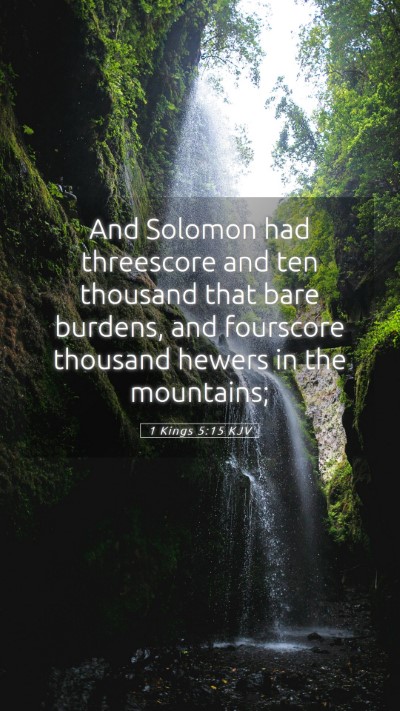Old Testament
Genesis Exodus Leviticus Numbers Deuteronomy Joshua Judges Ruth 1 Samuel 2 Samuel 1 Kings 2 Kings 1 Chronicles 2 Chronicles Ezra Nehemiah Esther Job Psalms Proverbs Ecclesiastes Song of Solomon Isaiah Jeremiah Lamentations Ezekiel Daniel Hosea Joel Amos Obadiah Jonah Micah Nahum Habakkuk Zephaniah Haggai Zechariah Malachi1 Kings 5:15 Meaning
What is the meaning of 1 Kings 5:15?
And Solomon had threescore and ten thousand that bare burdens, and fourscore thousand hewers in the mountains;
1 Kings 5:15 Bible Verse Meaning
Understanding 1 Kings 5:15 - Bible Verse Commentary
Bible Verse: 1 Kings 5:15 - "And Solomon had threescore and ten thousand that bare burdens, and fourscore thousand hewers in the mountains;"
Overview
This verse describes the workforce that King Solomon employed for the construction of the Temple in Jerusalem. It highlights the significant number of laborers, giving insight into the scale and ambition of this monumental building project. Through a combination of the burden bearers and stone workers, it sets the stage for understanding both the logistical and labor-intensive nature of Solomon's project.
Interpretations & Explanations
Historical Context
1 Kings 5:15 falls within a broader narrative of Solomon's reign and the preparation for building the Temple, which was a monumental undertaking reflecting God's covenant with Israel. The Temple was intended as a dwelling place for the Divine, signifying God's presence among His people. Public domain commentaries elucidate the importance of this project not just as a physical structure but as a symbol of Israel’s identity and faith.
Labor Force Composition
- Threescore and ten thousand: (70,000) laborers who were responsible for carrying loads, illustrating the necessity of a strong workforce to transport materials.
- Fourscore thousand hewers: (80,000) stone cutters working in the mountains, showing the reliance on skilled labor in acquiring the high-quality materials needed for the Temple.
Insights from Commentaries
According to Matthew Henry, this verse demonstrates Solomon's foresight and organization in securing a large and skilled workforce necessary for executing such an elaborate project.
Albert Barnes notes that this multitude signifies not just the physical effort but also the unity and purpose of Israel under Solomon's reign as they sought to honor God through the construction of the Temple.
Adam Clarke points out the symbolic significance of the numbers mentioned; the vast labor force reflects God’s providence in supplying what was necessary for fulfilling divine plans.
Theological Implications
This passage invites us to reflect on the means by which we achieve sacred ends. God's work often requires human involvement, effort, and resources. The enormity of the workforce underscores the collective effort that goes into worship and dedication to God’s purposes.
Application to Daily Life
In modern contexts, this scripture encourages us to recognize the value of teamwork and cooperation in accomplishing significant endeavors, especially in our spiritual lives and church activities. It serves as a reminder that, while individual contributions are vital, community efforts are often what lead to impactful results.
Additional Bible Cross References
- Exodus 35:30-35 - Details concerning the craftsmen called by God for building the Tabernacle.
- 1 Chronicles 22:2-4 - Discusses Solomon's preparations for the Temple and the large number of laborers.
- Ecclesiastes 4:9-12 - Highlights the benefits of working in partnership and the strength found in community.
Summary
The passage in 1 Kings 5:15 emphasizes the significant efforts made toward building the Temple, showcasing the scale of Solomon's project and its importance in the Israelite community. Resources, organization, and collaboration emerge as key elements that balance the divine with the practical. Interpreters of this verse can draw lessons on the importance of teamwork, dedication to divine tasks, and the understanding that significant efforts often require vast resources.
Conclusion
For those engaged in Bible study groups or seeking Bible study resources, 1 Kings 5:15 offers rich material for discussion about the nature of God's work and human collaboration. As you explore the meaning of Bible verses like this, consider how they apply to your context and what they reveal about God's ongoing work in our lives.


